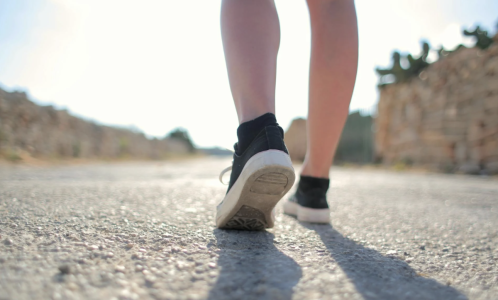Could a simple stride change help ease arthritis pain?
By
Veronica E.
- Replies 2
Disclaimer: The information provided in this article is for educational purposes only and is not intended as a substitute for professional medical advice, diagnosis, or treatment. Always consult your physician or other qualified healthcare providers with any questions you may have regarding a medical condition or before making any changes to your health regimen.
For millions of Americans living with arthritis, daily movement often comes with stiffness, discomfort, and a constant search for relief.
While treatment options range from medication to surgery, new research suggests that a simple, low-cost adjustment—changing the angle of your feet when you walk—may help.
A study published in The Lancet Rheumatology found that altering stride in a personalized way can reduce joint stress, improve function, and even provide pain relief similar to common over-the-counter medications.
While it’s not a cure, experts say this simple shift could be a useful addition to arthritis care.
Many believe it offers an accessible way to improve mobility without the need for medication or surgery.

How the study worked
The research team, led by Valentina Mazzoli, PhD, an assistant professor of radiology at NYU Grossman School of Medicine, examined 68 adults with knee osteoarthritis.
Each participant’s natural walking pattern was recorded on a treadmill, and a computer simulation calculated the maximum stress placed on their knees.
The researchers then created models of four alternative foot positions—angling the feet inward or outward by 5 or 10 degrees—and identified the position most likely to reduce knee stress for each individual.
Participants were randomly divided into two groups.
One group completed six training sessions to practice walking with their assigned foot angle, while the other group continued walking as they normally would.
Also read: Reverse your back pain and supercharge your brainpower with this counterintuitive trick
The results
After a year, those who adjusted their stride experienced a 4% reduction in maximum knee loading.
In contrast, the group that kept their usual stride saw an increase of more than 3%.
The stride-change group also reported an average 2.5-point drop on a 10-point pain scale—relief similar to what over-the-counter painkillers like NSAIDs or acetaminophen can provide—and demonstrated improved knee function.
Why stride matters
Osteoarthritis often affects joints that bear the most weight, such as the knees, hips, and feet.
While exercise has long been recommended to maintain mobility and muscle strength, this research focuses on how people move rather than just how often.
The findings suggest that small changes—such as shortening steps or slightly angling the toes outward—can alter the forces traveling through the joints, helping to reduce discomfort and protect cartilage over time.
Think of joints as hinges on a door: using them the same way repeatedly can cause wear, but adjusting the angle or movement can help preserve them.
Similarly, modifying walking mechanics may lessen unnecessary strain on the knees and hips.
Also read: Swollen fingers? Here’s what they might be telling you
Stride adjustments to consider
Also read: Struggling with knee pain? The surprising connection you might be overlooking
The role of footwear
Supportive shoes can make a difference in both comfort and stride mechanics.
Look for styles with cushioning, a wide toe box, arch support, and a flexible sole.
Specialty shoe stores or a consultation with a podiatrist can help identify the best options for healthy walking.
Why personalization matters
“These results highlight the importance of personalizing treatment instead of taking a one-size-fits-all approach,” Mazzoli said.
She noted that while changing gait can feel challenging, advances in motion-tracking technology, including artificial intelligence, could make it easier for patients to find and maintain their optimal foot angle.
Also read: Consider these 4 doctor-approved tips to help maintain strong, healthy bones
Consulting a professional
Stride changes are generally safe, but it’s best to consult a doctor or physical therapist before making significant adjustments—especially for those with balance issues or other health concerns.
A gait analysis can provide tailored recommendations for safer, more effective walking patterns.
Beyond walking
Low-impact activities such as swimming, cycling, and tai chi can complement stride adjustments by maintaining flexibility and strength without overloading the joints.
The key is to remain active while paying attention to your body’s signals.
While gait adjustment isn’t a cure, it offers a non-invasive, affordable way to help manage early-stage knee osteoarthritis.
Experts recommend working with a healthcare provider or physical therapist to find the safest and most effective foot position for your stride—potentially reducing the need for medication and improving comfort in daily life.
Read next: Suffering from joint pain? Discover 5 foods that could provide incredible relief!

Have you tried changing your stride to reduce arthritis pain? What strategies have worked for you in staying active with joint discomfort? Share your thoughts in the comments so others can learn from your experiences.
For millions of Americans living with arthritis, daily movement often comes with stiffness, discomfort, and a constant search for relief.
While treatment options range from medication to surgery, new research suggests that a simple, low-cost adjustment—changing the angle of your feet when you walk—may help.
A study published in The Lancet Rheumatology found that altering stride in a personalized way can reduce joint stress, improve function, and even provide pain relief similar to common over-the-counter medications.
While it’s not a cure, experts say this simple shift could be a useful addition to arthritis care.
Many believe it offers an accessible way to improve mobility without the need for medication or surgery.

Simple changes in movement may offer relief for those with joint pain. Image Source: Pexels / Andrea Piacquadio.
How the study worked
The research team, led by Valentina Mazzoli, PhD, an assistant professor of radiology at NYU Grossman School of Medicine, examined 68 adults with knee osteoarthritis.
Each participant’s natural walking pattern was recorded on a treadmill, and a computer simulation calculated the maximum stress placed on their knees.
The researchers then created models of four alternative foot positions—angling the feet inward or outward by 5 or 10 degrees—and identified the position most likely to reduce knee stress for each individual.
Participants were randomly divided into two groups.
One group completed six training sessions to practice walking with their assigned foot angle, while the other group continued walking as they normally would.
Also read: Reverse your back pain and supercharge your brainpower with this counterintuitive trick
The results
After a year, those who adjusted their stride experienced a 4% reduction in maximum knee loading.
In contrast, the group that kept their usual stride saw an increase of more than 3%.
The stride-change group also reported an average 2.5-point drop on a 10-point pain scale—relief similar to what over-the-counter painkillers like NSAIDs or acetaminophen can provide—and demonstrated improved knee function.
Why stride matters
Osteoarthritis often affects joints that bear the most weight, such as the knees, hips, and feet.
While exercise has long been recommended to maintain mobility and muscle strength, this research focuses on how people move rather than just how often.
The findings suggest that small changes—such as shortening steps or slightly angling the toes outward—can alter the forces traveling through the joints, helping to reduce discomfort and protect cartilage over time.
Think of joints as hinges on a door: using them the same way repeatedly can cause wear, but adjusting the angle or movement can help preserve them.
Similarly, modifying walking mechanics may lessen unnecessary strain on the knees and hips.
Also read: Swollen fingers? Here’s what they might be telling you
Stride adjustments to consider
- Shorten your steps: Smaller, controlled steps can reduce impact on joints.
- Slight toe-out position: A modest outward turn (about 5–10 degrees) may redirect pressure away from painful areas.
- Engage core muscles: A stable core supports better posture and smoother movement.
- Heel-to-toe motion: Rolling the foot forward instead of landing flat can help cushion each step.
- Use support when needed: A cane or walking stick can provide stability and reduce joint stress, particularly on uneven ground.
Also read: Struggling with knee pain? The surprising connection you might be overlooking
The role of footwear
Supportive shoes can make a difference in both comfort and stride mechanics.
Look for styles with cushioning, a wide toe box, arch support, and a flexible sole.
Specialty shoe stores or a consultation with a podiatrist can help identify the best options for healthy walking.
Why personalization matters
“These results highlight the importance of personalizing treatment instead of taking a one-size-fits-all approach,” Mazzoli said.
She noted that while changing gait can feel challenging, advances in motion-tracking technology, including artificial intelligence, could make it easier for patients to find and maintain their optimal foot angle.
Also read: Consider these 4 doctor-approved tips to help maintain strong, healthy bones
Consulting a professional
Stride changes are generally safe, but it’s best to consult a doctor or physical therapist before making significant adjustments—especially for those with balance issues or other health concerns.
A gait analysis can provide tailored recommendations for safer, more effective walking patterns.
Beyond walking
Low-impact activities such as swimming, cycling, and tai chi can complement stride adjustments by maintaining flexibility and strength without overloading the joints.
The key is to remain active while paying attention to your body’s signals.
While gait adjustment isn’t a cure, it offers a non-invasive, affordable way to help manage early-stage knee osteoarthritis.
Experts recommend working with a healthcare provider or physical therapist to find the safest and most effective foot position for your stride—potentially reducing the need for medication and improving comfort in daily life.
Read next: Suffering from joint pain? Discover 5 foods that could provide incredible relief!
Key Takeaways
- A study in The Lancet Rheumatology found that personalized foot-angle adjustments while walking can reduce knee stress in people with osteoarthritis.
- Researchers tested 68 participants, recording gait patterns and using simulations to identify the best inward or outward foot angle for each person.
- After a year, those who adjusted their stride saw a 4% drop in knee loading and a 2.5-point decrease in pain scores, while the control group’s knee stress increased.
- The approach may lower reliance on painkillers, improve knee function, and could become easier to adopt with AI-based motion analysis.
Have you tried changing your stride to reduce arthritis pain? What strategies have worked for you in staying active with joint discomfort? Share your thoughts in the comments so others can learn from your experiences.






